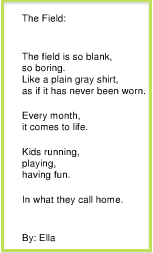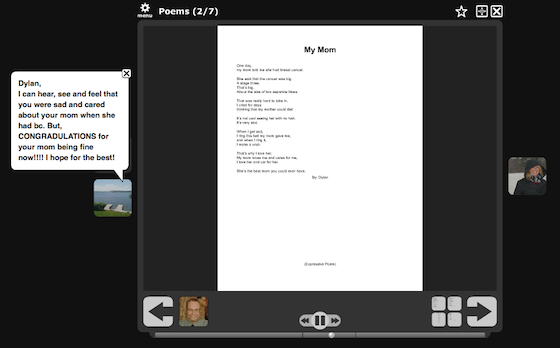Poetry has always been my favorite genre to teach because afterwards, most of my students believe in themselves as poets.
So it’s telling that poetry was my least favorite genre during my entire academic career. I detested poetry because many poets and poems were forced upon me and my interpretations of the poems were dictated to me as right or wrong. As a teacher, I’ve come to LOVE teaching poetry because I refuse to assume that gatekeeper role.
I believe that in many cases, there is no right way and wrong way to interpret a poem. My students and I interpret poems together. Now that my students and I are also connected through social media and the Internet, the study of poetry is even better. (I enjoyed throwing out my binder of transparencies!)
I believe that to effectively write in every genre, we need to read like we are writers. During my reading lessons, I guide my students to utilize the reading comprehension strategies of making inferences. I do this as I expose my students to a variety of poets. I read Sharon Creech’s books Love that Dog and Hate that Cat. In Love that Dog, Jack learns to love poetry after writing about his own loss. The story helps foster an appreciation for poetry in my young readers and writers.
Sharon Creech effectively helps kids appreciate the work of poets like William Carlos Williams, Robert Frost, Valerie Worth, and Walter Dean Myers for their power to make us feel and think. My teachers made me read their poems and answer the anthology questions. The grade I got on the assignment depended on how closely my understanding aligned with that of the publisher (and/or my teacher).
Hate that Cat focuses on teaching poetical attributes that historically are not taught in a fun way, such as onomatopoeia, alliteration, consonance, assonance, metaphors, similes and personification. Creech masterfully teaches poetical attributes in a fun and interesting way through the use of mentor poets and poems.
I use Ralph Fletcher’s book Poetry Matters to teach the fundamental aspects of writing poetry while fully engaging my students. He hones in on the three “pillars” of poetry: music, images and emotion. Georgia Heard’s book, Awakening the Heart was an integral book to foster the passion of poetry into me, and then my students. It helps get my kids to write from their hearts.
Nancy Atwell’s book Lessons That Change Writers, has excellent mini-lessons that teach kids the revision concepts that real poets use. She provides great mentor poems to model the strategies and supplies provocative quotes from poets that help me guide my own classroom poets.
How the technology blends in
I decide which of Atwell’s lessons to teach by reading my students’ poems and gauging what strategies they need to improve on. I post every lesson I teach, with mentor poems and quotes, on Edmodo. This way, if a student was absent, or needed/wanted a review, he had constant access to it.
Throughout the entire poetry unit, kids are writing drafts of their poetry. I ask them to prepare to publish six poems following these guidelines:
1. A poem with musical attributes
2. A poem that evokes emotion
3. A poem that uses figurative language
4. a poem that offers multisensory mind pictures
5. A poem inspired by a mentor poet
6. A “free-write” poem of their own choosing.
 Students use Google Docs to write their poems. They use the GDocs sharing function to share their poem documents with me and some of their classmates (if they choose). I read their poems (from anywhere at anytime), give them one specific comment, and offer one constructive suggestion to improve their poem that I hope also adds to their poetry writing repertoire.
Students use Google Docs to write their poems. They use the GDocs sharing function to share their poem documents with me and some of their classmates (if they choose). I read their poems (from anywhere at anytime), give them one specific comment, and offer one constructive suggestion to improve their poem that I hope also adds to their poetry writing repertoire.
This is the first year my students have had access to Google Docs. Prior to our utilization of it, I was only able to meet with each student about once or twice per poem due to time constraints. “Conferencing in the cloud” with Google Docs makes it possible for me to confer with each student much more than twice. Yes, there were a couple of kids I needed to persuade to share their poems with me, and they did reluctantly. But isn’t that always the case?
Google Docs keeps track of the comments kids and I make for each other (and the versions/drafts). Even though previously I had recorded my notes from my conferences with each student, it was hard to organize them very effectively and make good use of them. This year, because of Google Docs, I was easily able to return to the student’s poem and view my previous comments when I needed to remember what I had already suggested. This ability helped me see whether the student failed to understand my suggestion or perhaps just ignored it (both happen).
At the end of the unit, I had students go back and review their revision history. They were amazed by all of the changes they’d made.
Fifth graders like to keep moving!
I believe revision to be the most difficult part of the writing process for fifth graders. They truly believe that their first drafts are perfect with no need to make them better. The poetry unit (and Google Docs) offers a great way for kids to observe first-hand the benefits of revising because there are so few words and it’s easy to see how it changed. This is a fun unit to teach because my students love it and all they are all successful — even those who usually have a hard time adding details to their writing.
As a finale, students upload their poems to VoiceThread (unfortunately, it’s not compatible with Google Docs yet, so they have to copy and paste). As their poems are displayed (see Ella’s VT and Dylan’s VT as examples), students read their poetry aloud so the entire world can follow along and hear their poetry. The audience can then leave comments via text, video and/or voice message. Students have an authentic audience. And we all know the power of that!
Rachel Small
Latest posts by Rachel Small (see all)
- Reflecting on Reflection - March 12, 2013
- Twitter-Hacked! - July 10, 2012
- Teaching Poetry the Connected Way - May 1, 2012



Nicely done. I suppose you could scratch out the word “Poetry” and replace it with pretty much any topic…
Keep up the excellent work.
Thanks, Tim. You’re right; I use these methods with all genres I teach. For some reason, teaching poetry seems the most magical.
Great posting! It reminds me of the now (temporarily?) defunct Online Poetry Slam that literacyworkshop.org used to run. There were dozens of schools involved at its height. Go to http://literacyworkshop.org/poetryslam/poetryslam.htm if you want to see the last one.
Thank you for sharing the Online Poetry Slam link. I can’t wait to show my kids this.
I love the idea of going back to look at your revision history to see how far that you have come. Love that you incorporate that type of reflection into the process.
Nice post!
Thank you, Michael. Now I just need to incorporate more humor into my posts so I can make people laugh as you do so well!
I miss teaching poetry to my students. Having moved out of the classroom and just being a tech teacher, I don’t have that role anymore. Your method is much like what I came to using Wikispaces comment threads. All the versions were laid out in order, and it was easy to assess student progress and quality of feedback. Like Tim said, use this for any subject!
Along with Fletcher and Atwell, two of my favorite poetry teaching resources are Wishes, Lies, and Dreams by Kenneth Koch and I Am a Pencil by Sam Swope.
Looking forward to more posts!
Hey Dan! One of my fears of leaving the classroom would be to give up teaching literacy…You are able to help so many more students with your current position though.
I can’t wait to check out Kenneth Koch and Sam Swope.
I also appreciate your insight that I can accomplish a similar process with using Wikispaces comment threads. I fear I may not be able to use Google next year so you may have solved my problem.
Thank you so much!
I loved using a wiki in my classroom, and I just ran into someone who is forwarding me a contact at Wikispaces to talk about education wikis. I’ll post more on it at my blog if anything comes of it.
sounds like google docs could radically change teaching all by itself. a radical freedom to teach and be taught anywhere anytime
by the way, i didn’t teach with transparencies very many semesters, but i was glad to be able to throw them all out. the people at the apple store in berkeley (i purchased the one-on-one with my air mac) are doing a good job at bringing my tools up to the 21st century. i intent on extending the plan when it expires.
I really love poetry, Poetry helps me express my own feelings. I usually write my own poetry in a scratch paper and a small notebook. ‘;,.”
Have a great day!
http://www.foodsupplementdigest.com“>
Hi Wendi,
Writing poetry is extremely therapeutic for me too! I’m actually on my way to the beach to write some now.
Keep writing,
Rachel